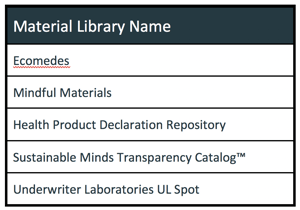Green Building Standards, Labels and Libraries
 There is a growing desire to making healthier supply chain choices to create green building products. According to IMARC Group, the global green building materials market from 2018-2023 is projected to reach a value of $387.9 billion (a compound annual growth rate of nearly 12%).
There is a growing desire to making healthier supply chain choices to create green building products. According to IMARC Group, the global green building materials market from 2018-2023 is projected to reach a value of $387.9 billion (a compound annual growth rate of nearly 12%).
There are so many tools and labeling methods that it can be daunting to know where to begin.
We acknowledge that there are many green building standards. They aren’t going away. And, they only partially overlap. They cover a variety of performance standards, from site location and aesthetics to materials, energy and water use.
Let’s look at three key factors to green building product success: meeting standards, labeling your products, and getting noticed.
1. Meeting Standards
There are a number of green building certification systems to choose from. The US EPA and Green Building Alliance have each created comparisons of the most common standards. Take a look at these links to get a sense of the different standards.
In the US, LEED (Leadership in Energy and Environmental Design) is the widely-used system established by the US Green Building Council, which offers a range of levels including: Certified, Silver, Gold and Platinum. Developed by the International Living Future Institute (ILFI), the Living Building Challenge standards are regarded as the most rigorous standards to achieve.
The WELL Building Standard focuses primarily on occupant wellness and health which includes materials selection. Consider prioritizing the requirements for one particular standard over the others based on most common customer requests or internal preferences.
2. Put a Label on it
Third-party green building product labeling systems are plentiful, and the list is growing. For example, Health Product Declarations (HPD), Declare Labels and LEED Manufacturer Inventories are three of the most widely used programs to help manufacturers get their products approved for use in green building certifications.
The HPD Open Standard is the leading benchmark for reporting and disclosing the contents of building products and their associated health information. Declare Labels are used to inform consumers of the origin of a product, the substances in it, and information about its fate at the end of its useful life.
Let the certification standard you chose in Step 1 guide your label decision, as not all labels are accepted by all building standards. To overcome this hurdle, an automated system can help to understand the overlap that does exist and serve as a systemized way to report on your efforts. This is why Toxnot created partnerships based on collaborative goals to increase the use of safer materials in the building industry.
3. Get Noticed
Finally, how do you ensure that architects, designers and other decision-makers will know that your product meets their specifications for a specific green building standard? We’re not talking about sending out product brochures or cold-calling architects.
If you’ve gone through the work to ensure your product is free of harmful chemicals, then add it to a material library that architects and other buyers routinely scour for new products. Below is a list of some of the popular single and multi-attribute sustainable material libraries to consider:

By submitting your product transparency data to one or more of these sites, you put your product(s) in front of purchasers. To streamline this process for Toxnot users, we have integrated with Giga’s internationally-recognized Origin Material Hub. From here, materials may be listed on the mindful MATERIALS Library, the industry-leading solution for architects to find transparency data.
Regardless of the standards, labels and libraries you chose to use, the next generation of consumers is counting on you to take action. And, the green building market is continuing to grow. Let us know which steps you've taken to green your building product designs.


